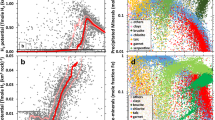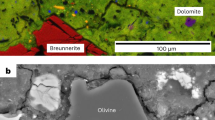Abstract
Several lines of geological and geochemical evidence indicate that the level of atmospheric oxygen was extremely low before 2.45 billion years (Gyr) ago, and that it had reached considerable levels by 2.22 Gyr ago. Here we present evidence that the rise of atmospheric oxygen had occurred by 2.32 Gyr ago. We found that syngenetic pyrite is present in organic-rich shales of the 2.32-Gyr-old Rooihoogte and Timeball Hill formations, South Africa. The range of the isotopic composition of sulphur in this pyrite is large and shows no evidence of mass-independent fractionation, indicating that atmospheric oxygen was present at significant levels (that is, greater than 10-5 times that of the present atmospheric level) during the deposition of these units. The presence of rounded pebbles of sideritic iron formation at the base of the Rooihoogte Formation and an extensive and thick ironstone layer consisting of haematitic pisolites and oölites in the upper Timeball Hill Formation indicate that atmospheric oxygen rose significantly, perhaps for the first time, during the deposition of the Rooihoogte and Timeball Hill formations. These units were deposited between what are probably the second and third of the three Palaeoproterozoic glacial events.
This is a preview of subscription content, access via your institution
Access options
Subscribe to this journal
Receive 51 print issues and online access
$199.00 per year
only $3.90 per issue
Buy this article
- Purchase on Springer Link
- Instant access to full article PDF
Prices may be subject to local taxes which are calculated during checkout




Similar content being viewed by others
References
MacGregor, A. M. The problem of the Precambrian atmosphere. S. Afr. J. Sci. 23, 155–172 (1927)
Rasmussen, B. & Buick, R. Redox state of the Archean atmosphere: Evidence from detrital heavy minerals in ca. 3250–2750 Ma sandstones from the Pilbara Craton, Australia. Geology 27, 115–118 (1999)
England, G. L., Rasmussen, B., Krapez, B. & Groves, D. I. Paleoenvironmental significance of rounded pyrite in siliciclastic sequences of the Late Archean Witwatersrand Basin: Oxygen-deficient atmosphere or hydrothermal alteration? Sedimentology 49, 1133–1156 (2002)
Beukes, N. J. & Klein, C. Geochemistry and sedimentology of a facies transition—from microbanded to granular iron-formation—in the early Proterozoic Transvaal Supergroup, South Africa. Precambr. Res. 47, 99–139 (1990)
Yang, W. & Holland, H. D. The redox-sensitive trace elements, Mo, U, and Re in Precambrian carbonaceous shales: Indicators of the Great Oxidation Event. Geol. Soc. Am. Abstr. Programs 34, 381 (2002)
Holland, H. D. in Early Life on Earth (ed. Bengston, S.) 237–244 (Columbia Univ. Press, New York, 1994)
Habicht, K. S., Gade, M., Thamdrup, B., Berg, P. & Canfield, D. E. Calibration of sulfate levels in the Archean Ocean. Science 298, 2372–2374 (2002)
Chandler, F. W. Proterozoic redbed sequences of Canada. Can. Geol. Surv. Bull. 311 (1980)
Chandler, F. W. Diagenesis of sabkha-related, sulphate nodules in the Early Proterozoic Gordon Lake Formation, Ontario, Canada. Carbon. Evapor. 3, 75–94 (1988)
El Tabakh, M., Grey, K., Pirajno, F. & Schreiber, B. C. Pseudomorphs after evaporitic minerals interbedded with 2.2 Ga stromatolites of the Yerriba basin, Western Australia: Origin and significance. Geology 27, 871–874 (1999)
Beukes, N. J. & Klein, C. in Proterozoic Biosphere (eds Schopf, J. W. & Klein, C.) 147–151 (Cambridge Univ. Press, Cambridge, UK, 1992)
Rye, R. & Holland, H. D. Paleosols and the evolution of atmospheric oxygen: A critical review. Am. J. Sci. 298, 621–672 (1998)
Strauss, H. in Precambrian Sedimentary Environments: A Modern Approach to Ancient Depositional Systems (eds Altermann, W. & Corcoran, P. L.) 67–105 (Blackwell Science, Oxford, 2002)
Dimroth, E. & Kimberley, M. M. Precambrian atmospheric oxygen: Evidence in the sedimentary distribution of carbon, sulfur, uranium, and iron. Can. J. Earth Sci. 13, 1161–1185 (1976)
Clemmey, H. & Badham, N. Oxygen in the Precambrian atmosphere: An evaluation of the geological evidence. Geology 10, 141–146 (1982)
Phillips, G. N., Myers, R. E. & Palmer, J. A. Problems with the placer model for Witwatersrand gold. Geology 15, 1027–1030 (1987)
Ohmoto, H. Evidence in pre-2.2 Ga paleosols for the early evolution of the atmospheric oxygen and terrestrial biota. Geology 24, 1135–1138 (1996)
Farquhar, J., Bao, H. & Thiemens, M. Atmospheric influence of Earth's earliest sulfur cycle. Science 289, 756–758 (2000)
Ono, S. et al. New insights into Archean sulfur cycle from mass-independent sulfur isotope records from the Hamersley Basin, Australia. Earth Planet. Sci. Lett 213, 15–30 (2003)
Farquhar, J. et al. Mass-independent sulfur of inclusions in diamond and sulfur recycling on early Earth. Science 298, 2369–2372 (2002)
Farquhar, J., Savarino, J., Airieau, S. & Thiemens, M. H. Observation of wavelength-sensitive mass-independent sulfur isotope effects during SO2 photolysis: Implications for the early atmosphere. J. Geophys. Res. 106, 1–11 (2001)
Romero, A. B. & Thiemens, M. Mass-independent sulfur isotopic compositions in sulfate aerosols and surface sulfates derived from atmospheric deposition: Possible sources of the MI anomaly and implications for atmospheric chemistry. Eos 83(Fall Meet. Suppl.), B71A–0731 (2002)
Pavlov, A. A. & Kasting, J. F. Mass-independent fractionation of sulfur isotopes in Archean sediments: Strong evidence for an anoxic Archean atmosphere. Astrobiology 2, 27–41 (2002)
Martini, J. E. J. The fluorite deposits in the Dolomite Series of the Marico District, Transvaal, South Africa. Econ. Geol. 71, 625–635 (1976)
Bau, M., Beukes, N. J. & Romer, R. L. Increase of oxygen in the Earth's atmosphere and hydrosphere between ∼2.5 and ∼2.4 Ga B.P. Mineral. Mag. A 62, 127–128 (1998)
Cameron, E. M. Sulphate and sulphate reduction in early Precambrian oceans. Nature 296, 145–148 (1982)
Eriksson, K. A. The Timeball Hill Formation—A fossil delta. J. Sedim. Res. 43, 1046–1053 (1973)
Coetzee, L. L. . Genetic Stratigraphy of the Paleoproterozoic Pretoria Group in the Western Transvaal Thesis, Rand Afrikaans Univ. (2001)
Eriksson, P. G. & Recsko, B. F. F. Contourites associated with pelagic mudrocks and distal delta-fed turbidites in the Lower Proterozoic Timeball Hill Formation epeiric basin (Transvaal Supergroup), South Africa. Sedim. Geol. 120, 319–335 (1998)
Visser, J. N. J. The Timeball Hill Formation at Pretoria—A prograding shore-line deposit. Ann. Geol. Surv. (S. Afr.) 9, 115–118 (1971) (1971–72)
Visser, J. N. J. in Earth's Pre-Pleistocene Glacial Record (eds Hambrey, M. J. & Harland, W. B.) 180–184 (Cambridge Univ. Press, New York, 1981)
Schieber, J. Microbial mats in terrigenous clastics: The challenge of identification in the rock record. Palaios 14, 3–12 (1999)
Hu, G., Rumble, D. & Wang, P.-L. An ultraviolet laser microprobe for in situ analysis of multi-sulfur isotopes and its use in measuring Archean sulfur isotope mass-independent anomalies. Geochim. Cosmochim. Acta 67, 3101–3118 (2003)
Miller, M. F. Isotopic fractionation and the quantification of 17O anomalies in the oxygen three-isotope system: An appraisal and geochemical significance. Geochim. Cosmochim. Acta 66, 1881–1889 (2002)
Farquhar, J. et al. Multiple sulphur isotopic interpretations of biosynthetic pathways: Implications for biological signatures in the sulphur isotope record. Geobiology 1, 27–36 (2003)
Beukes, N. J., Dorland, H. C. & Gutzmer, J. Pisolitic ironstone and ferricrete in the 2.22–2.4 Ga Timeball Hill Formation, Transvaal Supergroup: Implications for the history of atmospheric oxygen. Geol. Soc. Am. Abstr. Programs 34, 283 (2002)
Schweigart, H. Genesis of the iron ores of the Pretoria Series, South Africa. Econ. Geol. 60, 269–298 (1965)
Hannah, J. L., Stein, H. J., Bekker, A., Markey, R. J. & Holland, H. D. Chondritic initial 187Os/188Os in Paleoproterozoic shale (seawater) and the onset of oxidative weathering. Geochim. Cosmochim. Acta 67 (2003) A-34
Bekker, A. et al. Chemostratigraphy of the Paleoproterozoic Duitschland Formation, South Africa: Implications for coupled climate change and carbon cycling. Am. J. Sci. 301, 261–285 (2001)
Mojzsis, S. J., Coath, C. D., Greenwood, J. P., McKeegan, K. D. & Harrison, T. M. Mass-independent isotope effects in Archean (2.5 to 3.8 Ga) sedimentary sulfides determined by ion microprobe analysis. Geochim. Cosmochim. Acta 67, 1635–1658 (2003)
Wing, B. A. et al. Δ33S, δ34S and δ13C constraints on the Paleoproterozoic atmosphere during the earliest Huronian glaciation. Geochim. Cosmochim. Acta 66, A840 (2002)
Roscoe, S. M. in Geology of Canadian Mineral Deposit Types (eds Eckstrand, O. R., Sinclair, W. D. & Thorpe, R. I.) P-1 10–23 (Geological Society of America, Denver, 1996)
Bekker, A. et al. Response of the exosphere to the 2.48–2.45 Ga superplume event. Geol. Soc. Am. Abstr. Programs 32 (2000) A-135
Pickard, A. L. SHRIMP U-Pb zircon ages for the Palaeoproterozoic Kuruman Iron Formation, Northern Cape Province, South Africa: Evidence for simultaneous BIF deposition on Kaapvaal and Pilbara Cratons. Precambr. Res. 125, 275–315 (2003)
Acknowledgements
We thank D. Lange for help with the SEM work; W. Yang for help with sample preparation; and J. Brouwer for giving us access to drill core EBA-2, which was drilled by Gold Fields Ltd in the Potchefstroom area, and is now stored by the Geological Survey of South Africa. This study was supported by the NASA-Ames Research Center, NASA, PRF/ACS, NSF and South African Research Foundation.
Author information
Authors and Affiliations
Corresponding author
Ethics declarations
Competing interests
The authors declare that they have no competing financial interests.
Rights and permissions
About this article
Cite this article
Bekker, A., Holland, H., Wang, PL. et al. Dating the rise of atmospheric oxygen. Nature 427, 117–120 (2004). https://doi.org/10.1038/nature02260
Received:
Accepted:
Issue Date:
DOI: https://doi.org/10.1038/nature02260
This article is cited by
-
Modern analogs for ammonia flux from terrestrial hydrothermal features to the Archean atmosphere
Scientific Reports (2024)
-
Reconciling discrepant minor sulfur isotope records of the Great Oxidation Event
Nature Communications (2023)
-
Changes in orogenic style and surface environment recorded in Paleoproterozoic foreland successions
Nature Communications (2023)
-
Direct production of molecular oxygen from carbon dioxide and helium ion collisions
Communications Chemistry (2023)
-
Extreme diversity of 12 cations in folding ALS-linked hSOD1 unveils novel hSOD1-dependent mechanisms for Fe2+/Cu2+-induced cytotoxicity
Scientific Reports (2023)
Comments
By submitting a comment you agree to abide by our Terms and Community Guidelines. If you find something abusive or that does not comply with our terms or guidelines please flag it as inappropriate.



